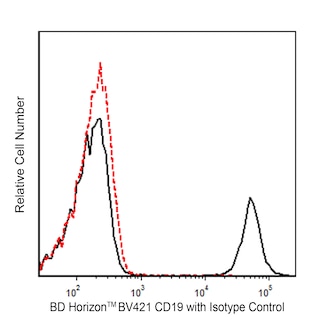-
Your selected country is
Middle East / Africa
- Change country/language
Old Browser
This page has been recently translated and is available in French now.
Looks like you're visiting us from {countryName}.
Would you like to stay on the current country site or be switched to your country?




Analyses of TCL1 expression Left Panel - Two-color flow cytometric analysis of TCL1 expression in human peripheral blood lymphocytes (PBL). Human peripheral blood mononuclear cells were stained with BD Horizon™ BV421 Mouse Anti-Human CD19 antibody(Cat. No. 562440/562441). The cells were washed, fixed, and permeabilized with the BD Cytofix/Cytoperm™ Fixation/Permeabilization Solution Kit (Cat. No. 554714). Cells were then stained with either Alexa Fluor® 647 Mouse IgG2b, κ Isotype Control (Cat. No. 565378; Left Plot) or Alexa Fluor® 647 Mouse Anti-Human TCL1 antibody (Cat. No. 565856; Right Plot). Two-color flow cytometric contour plots showing the correlated expression of CD19 versus TCL1 (or Ig Isotype control staining) were derived from gated events with the forward and side light-scatter characteristics of intact lymphocytes. Flow cytometric analysis was performed using a BD LSRFortessa™ X-20 Flow Cytometer System. Right Panel - Immunohistofluorescent staining of TCL1 in human tonsil. Following antigen retrieval with BD Pharmingen™ Retrievagen A Buffer (Cat. No. 550524), a formalin-fixed, paraffin-embedded human tonsil section was blocked using an Avidin/Biotin Blocking Kit (Vector Laboratories, Cat. No. SP-2001), then stained with Alexa Fluor® 647 Mouse Anti-Human TCL1 (Cat. No.565856 ; pseudocolored red) and BD Horizon™ BV421 Mouse Anti-Human CD45 (Cat. No. 563879/563880; pseudocolored green) antibodies. Nuclear or cytoplasmic TCL1 staining was detected in some cells. Images were acquired and merged using an epifluorescence microscopic system. Original magnification, 20×.


BD Pharmingen™ Alexa Fluor® 647 Mouse Anti-Human TCL1

Regulatory Status Legend
Any use of products other than the permitted use without the express written authorization of Becton, Dickinson and Company is strictly prohibited.
Preparation And Storage
Product Notices
- This reagent has been pre-diluted for use at the recommended Volume per Test. We typically use 1 × 10^6 cells in a 100-µl experimental sample (a test).
- Please refer to www.bdbiosciences.com/us/s/resources for technical protocols.
- The Alexa Fluor®, Pacific Blue™, and Cascade Blue® dye antibody conjugates in this product are sold under license from Molecular Probes, Inc. for research use only, excluding use in combination with microarrays, or as analyte specific reagents. The Alexa Fluor® dyes (except for Alexa Fluor® 430), Pacific Blue™ dye, and Cascade Blue® dye are covered by pending and issued patents.
- Alexa Fluor® 647 fluorochrome emission is collected at the same instrument settings as for allophycocyanin (APC).
- Alexa Fluor® is a registered trademark of Molecular Probes, Inc., Eugene, OR.
- Caution: Sodium azide yields highly toxic hydrazoic acid under acidic conditions. Dilute azide compounds in running water before discarding to avoid accumulation of potentially explosive deposits in plumbing.
- Source of all serum proteins is from USDA inspected abattoirs located in the United States.
- For fluorochrome spectra and suitable instrument settings, please refer to our Multicolor Flow Cytometry web page at www.bdbiosciences.com/colors.
- An isotype control should be used at the same concentration as the antibody of interest.
Companion Products






The 1-21 monoclonal antibody specifically binds to T-cell lymphoma-1 (TCL1), also known as, T-cell leukemia/lymphoma protein 1A (TCL1A). TCL1 is a ~14 kDa protein that belongs to the TCL1 protein family and is likewise known as p14TCL1. It is expressed in immature cortical thymocytes, activated T cells, pro-B cells, and a subset of naïve B cells in peripheral lymphoid tissues, but not in memory B cells and plasma cells. TCL1 plays a role in cell signaling responses. It associates with Akt at the inner plasma membrane leading to Akt phosphorylation and activation. This stimulates cell signaling responses through the MAPK/ERK pathway. TCL1 enhances T cell proliferation and survival. TCL1 is a proto-oncogene that has been associated with T-cell prolymphocytic leukemias and certain B cell neoplasias.
Development References (6)
-
Gaudio E, Paduano F, Ngankeu A, et al. Heat shock protein 70 regulates Tcl1 expression in leukemia and lymphomas. Blood. 2013; 121(2):351-359. (Biology). View Reference
-
Herling M, Patel KA, Khalili J, et al. TCL1 shows a regulated expression pattern in chronic lymphocytic leukemia that correlates with molecular subtypes and proliferative state. Leukemia. 2006; 20(2):280-285. (Immunogen: Flow cytometry, Fluorescence microscopy, Immunofluorescence, Immunohistochemistry, Western blot). View Reference
-
Herling M, Patel KA, Teitell MA, et al. High TCL1 expression and intact T-cell receptor signaling define a hyperproliferative subset of T-cell prolymphocytic leukemia. Blood. 2008; 111(1):328-337. (Immunogen: Flow cytometry, Fluorescence microscopy, Immunofluorescence, Immunohistochemistry, Immunoprecipitation, Western blot). View Reference
-
Palamarchuk A, Yan PS, Zanesi N, et al. Tcl1 protein functions as an inhibitor of de novo DNA methylation in B-cell chronic lymphocytic leukemia (CLL). Proc Natl Acad Sci U S A. 2012; 109(7):2555-2560. (Biology). View Reference
-
Pekarsky Y, Palamarchuk A, Maximov V, et al. Tcl1 functions as a transcriptional regulator and is directly involved in the pathogenesis of CLL. Proc Natl Acad Sci U S A. 2008; 105(50):19643-19648. (Biology). View Reference
-
Widhopf GF 2nd, Cui B, Ghia EM, et al. ROR1 can interact with TCL1 and enhance leukemogenesis in Eμ-TCL1 transgenic mice. Proc Natl Acad Sci U S A. 2014; 111(2):793-798. (Clone-specific: Immunoprecipitation, Western blot). View Reference
Please refer to Support Documents for Quality Certificates
Global - Refer to manufacturer's instructions for use and related User Manuals and Technical data sheets before using this products as described
Comparisons, where applicable, are made against older BD Technology, manual methods or are general performance claims. Comparisons are not made against non-BD technologies, unless otherwise noted.
For Research Use Only. Not for use in diagnostic or therapeutic procedures.
Report a Site Issue
This form is intended to help us improve our website experience. For other support, please visit our Contact Us page.